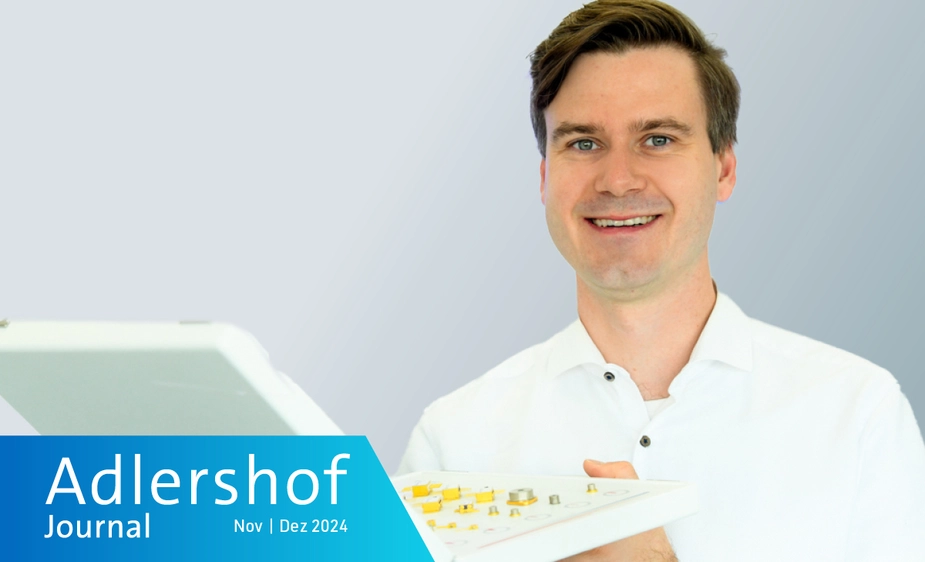In conversation with Björn Globisch
The PhD physicist is the head of research and development and frontend at TOPTICA EAGLEYARD
The laser diodes of TOPTICA EAGLEYARD find use in manifold areas of the industrial sector, the biosciences, the spaceflight industry, and research. After stints at Fraunhofer Heinrich-Hertz-Institut (HHI) and a junior professorship at Technische Universität Berlin (TU), Björn Globisch started leading the teams for chip development (frontend) and research and development (R&E) in 2024. Adlershof Journal spoke to the PhD physicist about new product developments and generational shifts.
Adlershof Journal: Have you settled into the day-to-day work at EAGLEYARD?
Björn Globisch: Things are going great now. It was very challenging in the beginning due to the wide variety of new topics. But the work is a lot of fun because every team brings in their specialist knowledge into the projects, creating an amazing new product in the end. I am learning a lot because I can not only work with the laser diodes themselves but also with system integration, control electronics, and software.
What will your development work focus on in the future and what are potential new applications?
The focus of our R&D work is currently on laser diodes for use in quantum technology. The main aim here is to replace large laser systems with smaller, stable, but equally powerful laser diodes in order to bring quantum technology from the lab table to application. This will be the key to success in the coming years and we can make a decisive contribution to it. At the same time, we ensure that every product development can be easily transferred into series production, to achieve rapid scaling in this way. With our laser diodes, our goal goes far beyond supporting the construction of prototypes. Their primary application is in higher quantities, e.g., in the life science and industrial sector.
Are applications conceivable that promise solutions to the so-called Grand Challenges—say, in the medical sector?
Yes, in fact, we are currently working on novel laser diodes in the medical sector. Here, our laser diodes are to be used to detect strokes clearly and early on to ensure that ambulances are directed straight to the appropriate urgent care clinic for further treatment. Lasers can also be used to build extremely sensitive magnetic field sensors. In the future, this technology will be used to control new types of prostheses or measure brain waves with unprecedented accuracy. Here, we are working together with highly innovative, international companies, who are developing these ideas and bringing them to product maturity with us.
EAGLEYARD is a spin-off of Ferdinand Braun Institute (FBH). What other research institutions are you currently collaborating with?
Even 22 years after spinning out from FBH, cooperation with research institutions remains an important pillar of our development work. As a high-technology company, it is crucial to know the newest research results early on and think about commercialisation. We are working with the Fraunhofer Heinrich-Hertz-Institut and the Fraunhofer Institute for Reliability and Microintegration, but also Humboldt-Universität zu Berlin. The Adlershof campus offers the advantage of being able to implement projects and experiments quickly. Now and then, ideas come up while we’re having lunch together.
Is the company going through a generational shift, and how do you benefit from each other?
Several of our long-standing employees have retired in recent years or will be retiring in the years to come. Jörg Muchametow, one of EAGLEYARD’s co-founders, is one example. He retired in late November 2023. Personally, I find the exchange with experienced team members particularly valuable because I can learn from tapping into their wealth of experience.
What do you do to balance your work?
In my free time, I enjoy cooking. Road cycling helps me clear my mind, and playing music with friends—I've played the piano and organ for many years and recently took up the keyboard. It gives me a chance to fully express my creativity.
Peggy Mory for Adlershof Journal
